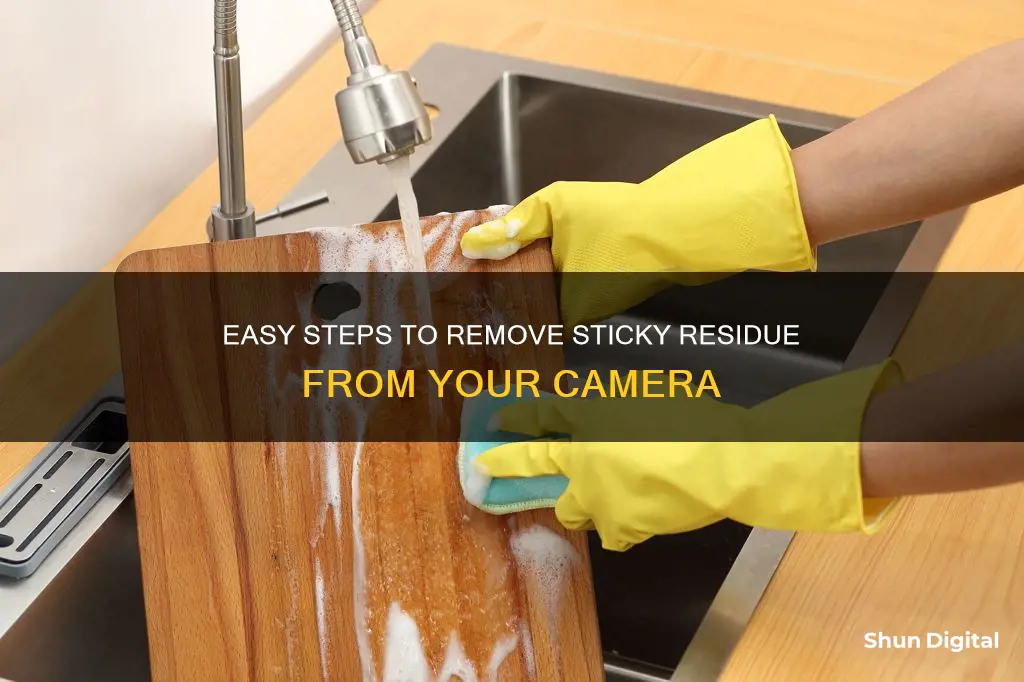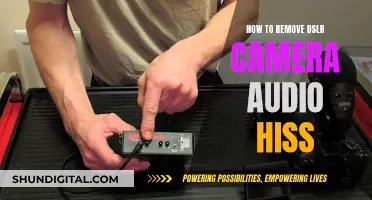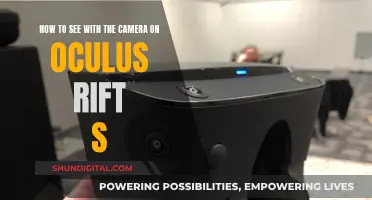
Removing sticky residue from a camera can be a tricky task, especially if the wrong products are used. The stickiness is often caused by the natural breakdown of rubberised material on the camera's body. While some suggest using products like Goo Gone, nail polish remover, or even lighter fluid, these can contain acetone, which can damage plastics. Instead, a better option is to use a soft cloth or cotton swab dipped in a solution of 90% or higher isopropyl (rubbing) alcohol. This method has proven successful for cleaning Nikon, Canon, and Minolta camera bodies.
| Characteristics | Values |
|---|---|
| Method | Isopropyl alcohol, lighter fluid, methylated spirits, acetone, baby powder, ArmorAll wipes, lacquer, clearcoat spray, Goo Gone, ethyl alcohol, household alcohol, lens cleaner liquid, de-greaser, dubbin wax, flour, talcum powder, adhesive tape, nail polish, nail polish remover, de-greaser, lighter fluid, de-greaser, de-greaser, de-greaser |
| Tools | Clean, soft tissue, toothbrush, small model brush, lint-free cloth, microfiber cloth, cotton swab, cotton bud, paper towel, paper kitchen towel, ear buds, toothbrush, adhesive tape, rubber bulb, lens wipe, goggles, gloves, cotton cloth, microfibre cloth |
| Other | Be patient, change tissue areas, keep at it, use a gentle wipe, don't rub it dry, let it dry between applications, use in a well-ventilated room, buff the grips, use a thin film of lacquer, use a thin layer once a day, let the alcohol evaporate before repeating, cover glass with plastic wrap, use a rubber band, use a cotton pad underneath |
What You'll Learn

Use isopropyl alcohol and a soft tissue
To remove sticky residue from your camera using isopropyl alcohol and a soft tissue, follow these steps:
Firstly, ensure you are wearing gloves and safety glasses. Isopropyl alcohol can be absorbed into the skin in large amounts, so it is important to take precautions. You should also work in a well-ventilated area, as it is harmful if breathed in.
Next, place your camera on a clean surface. Impregnate a clean, soft tissue with the isopropyl alcohol and gently start rubbing the sticky area. Be careful not to get the alcohol into any electronic areas, such as switches or small openings. The tissue will become filthy with the sticky residue, so be sure to change to a clean section of the tissue often. Keep rubbing with a clean tissue until there is no more residue on the tissue, and the job is done.
You may need to reapply the isopropyl alcohol a few times, as it evaporates quickly. Once all the sticky residue has been removed, give the camera a final wipe with a clean, dry tissue.
This method has proven successful for removing sticky residue from camera bodies, particularly those made of hard plastic. It is a simple and effective remedy for an annoying problem.
Sunlight Photography: Capturing the Perfect Shot
You may want to see also

Try lighter fluid
If you want to remove sticky residue from your camera, lighter fluid can be an effective solution. However, it's important to proceed with caution as it can be dangerous if mishandled. Here's a step-by-step guide on how to use lighter fluid to remove sticky residue from your camera:
Step 1: Choose the Right Lighter Fluid
Select a suitable lighter fluid, such as Ronsonol or Zippo, which are known to be effective and widely available. These products are designed to be used with lighters and are less likely to damage your camera's surfaces. Avoid using grill lighter fluid, as it may not be suitable for this purpose.
Step 2: Prepare the Work Area
Lighter fluid contains naphtha, which can be harmful to your skin, lungs, and other parts of your body. Ensure you are working in a well-ventilated area to minimise the risk of inhaling fumes. It is highly recommended to wear protective gear, such as latex gloves, to safeguard your skin.
Step 3: Test on a Small Area
Before applying lighter fluid to the affected area, test it on a small, inconspicuous part of your camera. This will help you determine if the fluid reacts adversely to the material of your camera. Apply a small amount of lighter fluid to a cotton swab or a clean cloth and gently rub it on an unseen area. Wait a few minutes to ensure it doesn't cause any discolouration or damage.
Step 4: Apply Lighter Fluid
Once you've confirmed that the lighter fluid is safe to use on your camera, it's time to apply it to the sticky residue. Using a cotton swab or a clean cloth, gently dab the lighter fluid onto the affected area. Be careful not to apply too much fluid at once, as it can drip and spread to other parts of the camera. You can also use a dropper for more precise application. Allow the fluid to sit for a minute or two.
Step 5: Remove the Residue
After the lighter fluid has had time to work its magic, use a soft, clean cloth or a label lifter (a plastic scraper or an old credit card with a beveled edge) to gently lift and remove the sticky residue. Work slowly and carefully to avoid damaging the camera's surface. If the residue is particularly stubborn, you may need to reapply the lighter fluid and let it soak for a little longer before trying again.
Step 6: Clean and Dry
Once you've successfully removed the sticky residue, use a clean cloth or paper towel to wipe away any remaining fluid or adhesive residue. Ensure that you thoroughly clean the area and allow it to dry completely. You may need to repeat this process a few times to fully remove all traces of the residue.
It is important to note that while lighter fluid can be effective for removing sticky residue, it may not be the best option for certain camera models or surfaces. Always exercise caution and test on a small area first. Additionally, be sure to follow safety guidelines when handling lighter fluid to avoid any accidents.
Wyze Camera: Is Someone Spying on You?
You may want to see also

Use a cloth and Edwal film cleaning solution
To remove sticky residue from your camera, you can use a cloth and Edwal film cleaning solution. Here's a step-by-step guide on how to do it:
First, make sure you have the right materials. You will need a soft cloth, such as a microfibre cloth, and the Edwal film cleaning solution. The Edwal cleaner is a liquid solution that is designed to remove fingerprints and dirt from films, slides, and movie films. It is safe to use and does not contain any harmful chemicals like carbon tet. You can purchase it online or from photography stores.
Next, prepare your workspace. The Edwal cleaning solution has strong fumes, so it is important to work in a well-ventilated area. Keep the bottle closed when not in use and avoid getting the solution on your skin. If needed, wear gloves to protect your hands.
Now, you can start cleaning your camera. Pour a small amount of the Edwal cleaning solution onto your cloth. You don't need to use a lot, just enough to dampen the cloth. Gently wipe the sticky areas of your camera with the cloth. Use gentle, circular motions and avoid applying too much pressure. Go over the sticky areas multiple times, using a clean part of the cloth each time. The cloth will help lift and remove the sticky residue from your camera.
After cleaning, make sure to dry the camera thoroughly. Use a dry, soft cloth to wipe down the camera and remove any remaining residue or moisture. You can also use compressed air to blow away any remaining residue. Allow the camera to air dry completely before using it again.
Finally, dispose of the used cloth and any remaining solution properly. The Edwal cleaning solution can be harmful to aquatic life, so do not pour it down the drain. Instead, dispose of it at a hazardous waste facility or according to your local guidelines.
By following these steps and using a cloth with Edwal film cleaning solution, you can effectively remove sticky residue from your camera and restore it to its original condition. Remember to always be gentle when cleaning your camera and to prioritize proper ventilation and disposal of chemicals.
Using Altec Lansing Cameras on PC: A Guide
You may want to see also

Apply lacquer or transparent nail polish
Applying lacquer or transparent nail polish is an effective way to deal with sticky residue on your camera. Here's a detailed guide to help you through the process:
Step 1: Choose the Right Nail Polish
Select a transparent nail polish that is suitable for the surface of your camera. It is important to choose a nail polish that is designed for the specific material of your camera, such as plastic or metal. Using the wrong type of nail polish may damage the surface.
Step 2: Prepare the Surface
Before applying the nail polish, ensure that the surface of your camera is clean and free of any dirt, dust, or debris. Use a soft microfiber cloth to gently wipe down the area where you will be applying the nail polish. This will help the nail polish adhere better and create a smoother finish.
Step 3: Apply the Nail Polish
Dip the brush into the nail polish bottle and carefully apply a thin, even layer of nail polish to the desired area on your camera. Be cautious not to apply too much pressure, as you want to avoid flooding the surface with nail polish. Start with a light coat and build up as needed.
Step 4: Allow the Nail Polish to Dry
After applying the nail polish, set it aside and allow it to dry completely. Nail polish typically takes a few minutes to dry, but you can refer to the manufacturer's instructions for a more precise drying time. Avoid touching or handling the camera during this period to prevent smudges or fingerprints.
Step 5: Inspect and Apply Additional Coats
Once the first coat of nail polish has dried, carefully inspect the surface for any signs of unevenness or missed spots. If necessary, apply a second thin coat to ensure complete coverage. Remember to allow each layer to dry thoroughly before adding another coat.
Step 6: Finishing Touches
After the final coat has dried, gently run your fingers over the surface to check for any stickiness. If the surface feels smooth and dry, your camera is ready to use. If you notice any imperfections or missed spots, you can carefully apply additional coats of nail polish to those specific areas.
Remember to always work in a well-ventilated area when using nail polish, as the fumes can be strong. Additionally, always store your nail polish in a cool, dry place when not in use to prevent it from thickening or becoming gloopy.
Monitoring Employees: Do Managers Watch the Camerad?
You may want to see also

Try methylated spirits
If you're looking to remove sticky residue from your camera, one suggested method is to use methylated spirits. Methylated spirits is a solvent that can be used to remove adhesives and sticky residues from various surfaces, including wood, glass, metal, and plastic. It is also known as denatured alcohol or methylated alcohol.
- Before you begin, make sure you are in a well-ventilated area as methylated spirits can produce strong fumes. It is also a good idea to wear gloves to protect your skin and avoid any potential irritation.
- Prepare the methylated spirits by pouring a small amount into a container. You can dilute the methylated spirits with water if you wish, but it is not necessary.
- Dip a clean, soft cloth into the methylated spirits. Alternatively, you can use a cotton ball or swab for smaller areas. Make sure the cloth or cotton is damp but not soaking wet.
- Gently rub the cloth or cotton onto the sticky residue on your camera. Apply light pressure and work in small circular motions. You may need to change to a clean section of the cloth or use a new cotton ball as the residue is transferred onto it.
- Continue rubbing until the sticky residue is gone. This may take a few minutes, depending on the severity of the build-up. Be patient and persistent, and avoid using too much pressure to prevent damaging the camera's surface.
- Once the residue is removed, use a slightly damp cloth to wipe down the camera and remove any remaining methylated spirits.
- Allow the camera to air dry completely before using it again.
It is important to note that while methylated spirits is a effective solvent, it is also flammable. Always exercise caution when handling it and keep it away from open flames or heat sources. Additionally, always read the instructions on the product label and follow any safety precautions.
If you are concerned about using methylated spirits on your camera, you can test it on a small, inconspicuous area first to ensure it does not cause any damage or discolouration.
Other solvents that can be used as alternatives to methylated spirits include isopropyl alcohol, lighter fluid, and nail polish remover (acetone). However, always research and test any solvent on a small area before applying it to the entire camera to avoid potential damage.
Removing Camera Timer: A Quick Guide to Spontaneous Captures
You may want to see also
Frequently asked questions
One way to remove sticky residue from your camera is to use isopropyl alcohol. Impregnate a clean, soft tissue with the alcohol and gently rub the sticky area.
If you don't have isopropyl alcohol, you can try using a slightly dampened cloth, lighter fluid, or even household alcohol.
When using isopropyl alcohol, it is important to be cautious as it can be harmful if breathed in. It is also not great for your skin, so it is recommended to wear gloves if possible.
If the sticky residue is on the lens of your camera, it is recommended to cover the glass with plastic wrap and a rubber band to protect it from any potential damage during the cleaning process.







